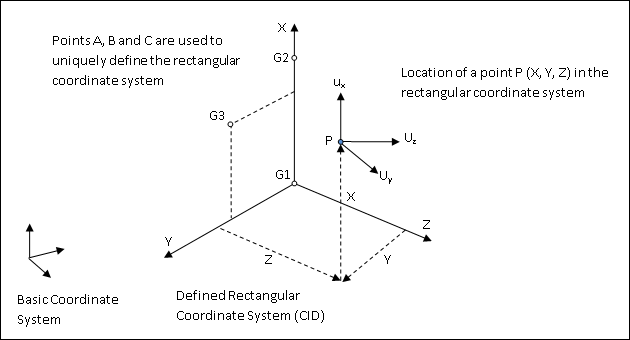CORD4R |

|

|

|

|
|
CORD4R |

|

|

|

|
Bulk Data Entry
CORD4R – Rectangular Coordinate System Definition, Form 4
Description
This entry defines a rectangular coordinate system using three grid points specified with respect to the basic coordinate system. The coordinates of the three non-collinear grid points are used to uniquely define the coordinate system. The first point is the origin, the second lies on the X-axis, and the third lies on the X-Y plane (see Figure 1).
Format
(1) |
(2) |
(3) |
(4) |
(5) |
(6) |
(7) |
(8) |
(9) |
(10) |
CORD4R |
CID |
|
A1 |
A2 |
A3 |
B1 |
B2 |
B3 |
|
|
C1 |
C2 |
C3 |
|
|
|
|
|
|
|
Field |
Contents |
CID |
Unique coordinate system identification number. (Integer > 0) |
A1,A2,A3 |
Coordinates of three points in the basic coordinate system. (Real) |

Figure 1: CORD4R definition.
| 1. | Coordinate system identification numbers on all CORD1R, CORD1C, CORD1S, CORD2R, CORD2C, CORD2S, CORD3R, and CORD4R entries must all be unique. |
| 2. | A duplicate identification number is allowed if the CID and GID are identical and the coordinates are within the value set by PARAM, DUPTOL (see Guidelines for Bulk Data Entries for further information). |
| 3. | The three points (A1, A2, and A3), (B1, B2, and B3), and (C1, C2, and C3) must be unique and non-collinear. Non-collinearity is checked by the geometry processor. |
| 4. | The location of a grid point (P in Figure 1) in this rectangular coordinate system is given by (X, Y, and Z). |
| 5. | The displacement coordinate directions at P are (Ux, Uv, and Uz) as shown in Figure 1. |
| 6. | A maximum of two coordinate systems may be defined on a single entry. |
| 7. | This card is represented as a system in HyperMesh. |
See Also: